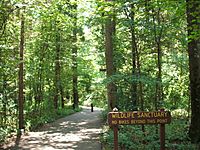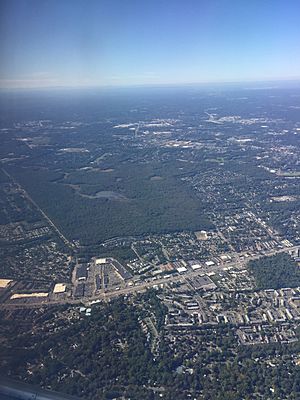Huntley Meadows Park facts for kids
Quick facts for kids Huntley Meadows Park |
|
|---|---|
 |
|
| Location | Hybla Valley, Fairfax County, Virginia, USA |
| Area | 1,452 acres (588 ha) |
| Created | 1975 |
| Operated by | Fairfax County Park Authority |
| Status | Open all year |
| Website | Official site: http://www.fairfaxcounty.gov/parks/huntley/ |
Huntley Meadows Park is the biggest park run by the Fairfax County Park Authority. It covers a huge area of about 1,452 acres! You can find it in the Hybla Valley part of Fairfax County, Virginia, just south of Alexandria.
This amazing park has a visitor center, a cool wetland created by beavers with a long boardwalk, and special spots to watch wildlife. There are also many trails for exploring. Huntley Meadows Park is home to lots of animals and plants. It's especially known for attracting many birds, amphibians, and plants that are not often seen in this area.
The park has many secondary-growth forests. These are forests that have grown back after being cut down. You'll also find several small meadows filled with native grasses and wildflowers. These meadows surround much of the wetland areas. The main waterways flowing through the park are Dogue Creek, Barnyard Run, and the start of Little Hunting Creek.
Contents
Park History: From Plantations to Park
The story of Huntley Meadows Park goes back a long time. In 1757, a very important person named George Mason bought this land. He was one of the Founding Fathers of the United States.
Around 1825, George Mason's grandson built a house called Huntley on a hill overlooking the property. This historic house is now listed on the National Register of Historic Places. Another grandson owned a nearby area called Okeley Manor, which is now part of the park. Later, in the late 1800s and early 1900s, the land was used for dairy farming.
From Farms to a Dream Airport
In the late 1920s, a businessman named Henry Woodhouse bought up many small pieces of land. He gathered about 1,500 acres from ten different landowners. Woodhouse had a big dream: he wanted to turn the dairy farms of Hybla Valley into the "George Washington Air Junction." He claimed it would be the biggest airport in the world! However, his dream didn't come true, and he lost most of the property.
Government Use and Park Creation
In 1941, the United States government bought the land. For many years, different government groups used it. From 1943 to 1953, the Bureau of Public Roads tested new asphalt for roads there.
Later, from 1950 to 1959, the Virginia National Guard used the land to protect the nation's capital from air attacks. Then, from 1958 to 1971, the United States Navy did secret radio research there. After that, the Navy decided they didn't need the land anymore.
In 1975, President Gerald Ford signed papers to give 1,261 acres of this land to the people of Fairfax County. It was given "exclusively for public park or public recreation purposes forever." This happened under a program called the Federal Legacy of Parks Program. The county paid only one dollar for the land! In 1992, the Fairfax County Park Authority bought another 165 acres of wetland and upland with help from Ducks Unlimited.
Huntley Meadows Park Today
After the federal government gave the land to Fairfax County in 1975, beavers quickly moved back into the area. They started building dams, which changed how water flowed through the land. This created a large wetland, now called the Central Wetland.
The number of different plants and animals (biodiversity) in this wetland quickly grew. In 1982, a boardwalk was built. This allows visitors to walk right into the wetland and see this amazing habitat up close. Today, over 200,000 people visit the park every year. They come to watch wildlife, get exercise, and relax in nature.
The park has a visitor center with staff who can answer questions. It has many exhibits about the park's human history and its natural environment. The center also offers educational programs for people of all ages.
A group called Friends of Huntley Meadows Park is a non-profit organization. They give a lot of help to the park. They work to protect the park's natural resources. They also help provide money for programs, internships, and equipment.
Wetland Restoration Project
A big project is planned to help manage and protect the Central Wetland. This "wetland restoration" project will help keep the wetland healthy and full of different plants and animals. It will include building a small concrete dam and creating shallow wetland pools. They will also place dead trees in the wetland to help wildlife. The project will also expand nearby park meadows using soil dug up from the wetland. This project will cost nearly three million dollars, paid for by voter-approved bonds.
Fun Activities at the Park
Huntley Meadows Park has over 10 miles of trails for you to explore! Some of these trails go over boardwalks, especially near the wetland areas. You'll find many watch areas and benches along the main Heron, Deer, and Cedar trails.
Wildlife Watching and Photography
The main thing people do at Huntley Meadows is watch birds and other wildlife. There are several observation towers and stations along the trails. The park is very famous in the area for nature photography. Both professional photographers and hobbyists love to take pictures here. Photos taken at the park have even won big awards! This includes the grand prize for the 2019 Audubon Photography Awards. There's even a public Facebook group called Huntley Meadows Park Photography with thousands of members.
Educational Programs and Events
The park also offers many fun and educational activities. You can join naturalist talks to learn about nature. There are school education programs and self-guided tours. Sometimes, there are even artistic performances in the park!
Park Geology: How the Land Formed
About 100,000 years ago, the land that is now Huntley Meadows Park was part of a bend in the Potomac River. About 30,000 years ago, the river straightened out to its current path. This left behind a U-shaped lake, called an oxbow lake. Over time, this lake filled in with dirt and plants. This is how Huntley Meadows and Hybla Valley were formed!
Amazing Plants and Animals
Huntley Meadows Park is bursting with life! Over 600 different types of plants and flowers have been found here. This includes more than 300 kinds of wildflowers. The park is also home to over 200 types of birds, 30 kinds of mammals, and 50 types of reptiles and amphibians. You can also spot about 50 different kinds of dragonflies and damselflies.
Dealing with Invasive Plants
Like many parks, Huntley Meadows has to deal with "non-native invasive plant species." These are plants that are not from the area and can spread quickly, harming the native plants. Japanese stiltgrass is one of these plants. It grows very well and can cover the forest floor. The park is working hard to fight it. For example, they have boot cleaning stations at the start of trails. This helps stop people from accidentally spreading the seeds of these unwanted plants.




